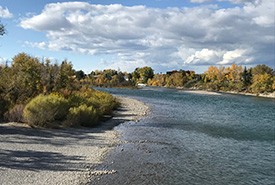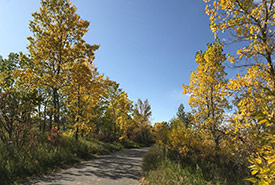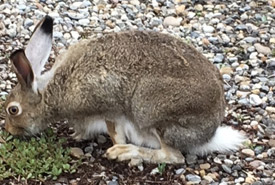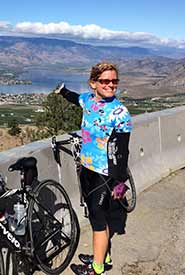Ode to a nature commute – part 1, fall

Early fall along the Bow River (Photo by Gayle Roodman/NCC staff)
Living in a city of a million people means noise, traffic, concrete and a need to go, go, go, right? What if I told you it also means immersing yourself in urban nature?
The mighty Bow River flows through Calgary, and city planners had their thinking caps on the day they decided to build multi-use paved pathways along its verdant banks. They must have known that increasing evidence shows that nature and green spaces in cities significantly improve our well-being and health. Anecdotally, I can confirm that this is indeed the case.
I’ve clocked a lot of kilometres bike commuting to and from work over the last two decades, in many different cities, through most weather scenarios imaginable, across this great country. The landscapes that I and my trusty two-wheeled steed have travelled are typical: from quiet city streets with roadside lemonade stands to four-lane arteries filled with people — myself included — focused on just getting to their destination.
Then I moved to a small town in the foothills west of Calgary. My year-round, daily commute now starts with a 20-minute drive to the west side of the city, where I park my car, take my bike off the rack, strap on my helmet and begin my ride to work.
I have the pleasure of spending 14 kilometres of my 20-kilometre-long-round-trip commute riding along the previously mentioned paved piece of pathway paradise, from the cusp of the suburbs, right into the heart of Calgary’s downtown core. And some days, I swear it takes me longer than necessary to get to my destination; it’s not uncommon for me to feel and give in to an urge to slow down, take it in, and to smell and admire the beauty of this riverside pathway.
Related content
In this four-part blog, I’ll take you on a tour of this urban nature — from the seat of my bike — in each of Calgary’s four seasons. No Lycra required.
There are so many things to love about fall. Cool, crisp air. Turning leaves. A respite from the summer heat….oh, wait. This is southern Alberta after all, and this past summer was, how to put it delicately, lousy, weather-wise. So, when I noticed the first sign of leaves turning in early September, I was not impressed.

Fall colours lining the bike path (Photo by Gayle Roodman/NCC staff)
All complaining aside, fall is still my favourite time to bike commute. Less busy pathways, piles of crunchy fallen leaves just begging to be ridden through, sun low in the sky, dappling its light through the Colorado spruce. The oranges and pinks of big-sky-country sunrises.
The early fall colours of the prairie grasses and shrubs and the brilliant golds of balsam poplar lining the pathway never cease to bring a smile to my face as I’m reminded of the splendour of Ontario’s (where I grew up) fall foliage. Like the turning of the leaves, I also witness the white-tailed jackrabbit’s transition from grey to white.
I love the nature sounds that accompany fall bike commuting. The crunching of the leaves as I ride over them, which often includes an intentional steer toward them. The tinkling as the thin layer of ice on a puddle cracks beneath my weight. Me “gently yelling” at the daredevil jackrabbits that dart across my path.

White-tailed jackrabbit (Photo by Conriz CC-BY-NC)
Over my career, I’ve inexplicably been drawn to organizations that are busiest during the fall, and the Nature Conservancy of Canada (NCC) is no exception. October and November in the editorial services department are a whirl of multiple deadlines and projects. My morning rides, along a car-free pathway, allow my mind to wander free and, if I choose, to plan my work day. But at the end of my day, as I pedal Sockeye (yes, I name my bikes) west through this urban nature, replete with benches to soak it in, I feel the workday’s stress roll off my shoulders and my head clear by the time I’m back at my car. Even bad days seem to disappear by the time I load my bike up on the car rack.
If you’re still unsure about this urban nature thing, check out NCC’s NatureTalks Cross-Country Speaker Series this fall as the series makes its way across Canada. Learn why discovering nature in our cities can change the quality of our urban lives.


